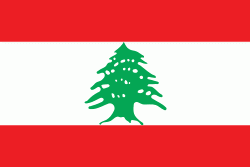Lebanese pound
لل
The pound or lira (ليرة لبنانية līra Libnāniyya; French: livre libanaise; abbreviation: LL in Latin, ل.ل. in Arabic, historically also £L, ISO code: LBP) is the currency of Lebanon. It was formerly divided into 100 piastres (or qirsh in Arabic) but because of high inflation during the Lebanese Civil War (1975–1990) the use of subunits was discontinued.The plural form of lira, as used in relation to the currency, is either lirat (ليرات līrāt) or invariant, whilst there were four forms for qirsh: the dual qirshān (قرشان) used with number 2, the plural qurush (قروش) used with numbers 3–10, the accusative singular qirshan (قرشا) used with 11–99, and the genitive singular qirshi (قرش) used with multiples of 100. The number determines which plural form is used. Before World War II, the Arabic spelling of the subdivision was غرش (girsh). All of Lebanon's coins and banknotes are bilingual in Arabic and French.
Since December 1997, the exchange rate has been fixed at LL 1,507.50 per US dollar. However, since the 2020 economic crisis in Lebanon exchange at this rate is generally unavailable, and an informal currency market has developed with much higher exchange rates.
Until World War I, the Turkish pound was the currency used in the area. In 1918, after the fall of the Ottoman Empire, the Egyptian pound was used. Upon gaining control of Syria and Lebanon, the French replaced the Egyptian pound with a new currency for Syria and Lebanon, the Syrian pound, which was linked to the franc at a value of LS 1 = 20 F. Lebanon issued its own coins from 1924 and banknotes from 1925. In 1939, the Lebanese currency was officially separated from that of Syria, though it was still linked to the French franc and remained interchangeable with Syrian money. In 1941, following France's defeat by Nazi Germany, the currency was linked instead to sterling at a rate of LL 8.83 = £1 stg. A link to the French franc was restored after the war, but was abandoned in 1949.
Before the third phase of the Lebanese Civil War, US$1 was worth: In 1986 the pound began to fall against the dollar. On 13 June a dollar was worth LL 36.50. two weeks later it was worth LL 47. During the Civil War, the value decreased rapidly until 1992, when one US dollar was worth over LL 2,500. Subsequently, the value increased again, and since December 1997 the official rate has been fixed at LL 1,507.50 = US$1.
* LL 3.07 in 1965
* LL 3.26 in 1970
* LL 2.25 in 1975
* about LL 4 in 1981
* LL 500 in 1987
Country
-
Lebanon
Lebanon (لُبْنَان, ; Liban), officially the Republic of Lebanon (الجمهورية اللبنانية) or the Lebanese Republic, is a country in Western Asia. It is located between Syria to the north and east and Israel to the south, while Cyprus lies to its west across the Mediterranean Sea; its location at the crossroads of the Mediterranean Basin and the Arabian hinterland has contributed to its rich history and shaped a cultural identity of religious diversity. It is part of the Levant region of the Middle East. Lebanon is home to roughly five million people and covers an area of 10452 km2, making it the second smallest country in continental Asia. The official language of the state is Arabic, while French is also formally recognized; the Lebanese Arabic is used alongside Modern Standard Arabic throughout the country.
The earliest evidence of civilization in Lebanon dates back to 5,000 BCE. From c. 3200–539 BC, it was home to the flourishing Phoenician civilization before being annexed by various Near Eastern empires. In 64 BC, the Roman Empire conquered the region, and the region became a major center for Christianity under the Byzantine Empire. In the 7th century, the Muslim conquest of the Levant established caliphal rule. The 11th century saw the start of the Crusades and the establishment of Crusader States in the region only for it to be later reclaimed by the Ayyubids and Mamluks before being ceded to the Ottoman Empire in the 16th century. Under Sultan Abdulmejid I, the first Lebanese protostate took form in the 19th century as the Mount Lebanon Mutasarrifate, created as a home for the Maronite Christians under the Tanzimat reforms.
